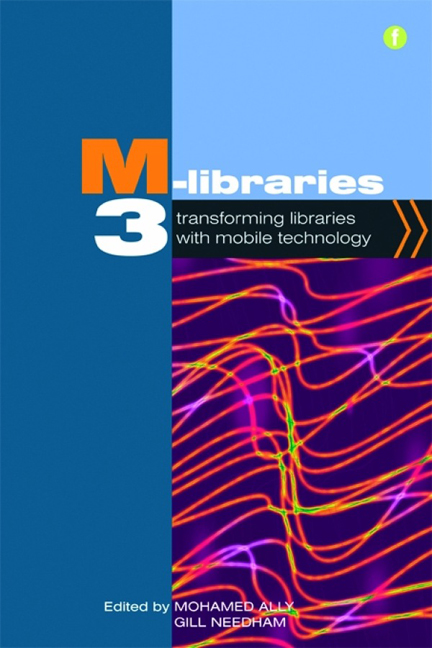Book contents
- Frontmatter
- Contents
- Acknowledgements
- Contributors
- Foreword
- Introduction
- 1 Education for all with mobile technology: the role of libraries
- PART 1 DEVELOPING MOBILE SERVICES
- PART 2 PEOPLE AND SKILLS
- PART 3 FOCUS ON TECHNOLOGY
- 15 Mobile services of the National Library of China
- 16 India's mobile technology infrastructure to support m-services for education and libraries
- 17 Use and user context of mobile computing: a rapid ethnographic study
- 18 Meeting the needs of library users on the mobile web
- 19 Mobile dynamic display systems for library opening hours
- 20 Device-independent and user-tailored delivery of mobile library service content
- 21 Designing effective mobile web presence
- Conclusion
- Index
20 - Device-independent and user-tailored delivery of mobile library service content
from PART 3 - FOCUS ON TECHNOLOGY
Published online by Cambridge University Press: 08 June 2018
- Frontmatter
- Contents
- Acknowledgements
- Contributors
- Foreword
- Introduction
- 1 Education for all with mobile technology: the role of libraries
- PART 1 DEVELOPING MOBILE SERVICES
- PART 2 PEOPLE AND SKILLS
- PART 3 FOCUS ON TECHNOLOGY
- 15 Mobile services of the National Library of China
- 16 India's mobile technology infrastructure to support m-services for education and libraries
- 17 Use and user context of mobile computing: a rapid ethnographic study
- 18 Meeting the needs of library users on the mobile web
- 19 Mobile dynamic display systems for library opening hours
- 20 Device-independent and user-tailored delivery of mobile library service content
- 21 Designing effective mobile web presence
- Conclusion
- Index
Summary
Introduction
With the advent of the smartphone and the explosion in the market for mobile applications (apps), a great opportunity has emerged for the delivery of library service content to a more diverse range of users and mobile devices. While a great many individuals use iPhone or Androidbased smartphones, which facilitate the delivery of these apps to users, a vast majority of the public are still left out of this particular loop. In enabling a much wider cohort of library users to access these services, the ‘app store’ concept has enormous potential for the enhanced delivery of learning and informational content. Whereas app stores are accessible only to certain classes of device, the aim of the system presented here is to enable any individual using a Java-enabled device to receive relevant service content tailored to their preferences and device capabilities. This chapter investigates the potential of this new architecture, encompassing mobility and the facilitation of a more personalized and contextualized information environment for library users. Also considered are the enhancements to traditional library services and practices that can be facilitated by the incorporation of these technologies, in particular the exciting possibilities they hold for a narrowing of the ‘digital divide’ and for revolutionizing learning in the case of distance learners and communities/populations previously starved of educational opportunities.
Throughout the 20th century and the early years of the 21st century, humanity's rate of technological advance has grown progressively swifter, with various technological innovations revolutionizing almost every aspect of life, from an individual level right up to the societal level. With the tremendous foothold that information and communications technologies (ICTs) have gained in society, it was only a matter of time before they were adopted in educational institutions and turned towards the enhancement of existing teaching and learning processes. In particular, the advent of the internet and the ability to access a seemingly infinite repository of information has altered the way people are approaching education. There have been many studies advocating greater integration of technology into education, such as Crouch and Mazur (2001), Garrison and Kanuka (2004) and Heinze and Proctor (2004). Many of these studies highlight that the use of new technologies by higher educational institutions in course delivery has become inevitable.
- Type
- Chapter
- Information
- M-Libraries 3Transforming libraries with mobile technology, pp. 181 - 190Publisher: FacetPrint publication year: 2012



